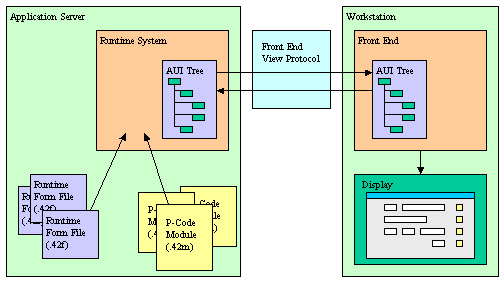The dynamic user interface
The dynamic user interface is the base concept of the Genero user interaction components.
The dynamic user interface (DUI) concept implements a flexible graphical user interface programming toolkit, based on the usage of XML standards, to define an abstract representation of the application forms. This abstract user interface representation can be displayed by different types of display devices called front-ends, which execute on the user workstation or on the same platform as the runtime system.
The abstract definition of the user interface can be manipulated at runtime as a tree of interface objects. This tree is called the abstract user interface tree.
The runtime system is in charge of the abstract user interface tree, and the front-end is in charge of rendering this abstract tree on the screen. The front-end gets a copy of that tree which is automatically synchronized by the runtime system by using the front-end protocol.
In development, application screens are defined by form specification files.
The following schema describes the dynamic user interface concept, showing how the abstract user Interface tree is shared by the runtime system and the front-end.

When the AUI trees are synchronized, only the changes are sent to or received from the front-end.
Note that when running on a mobile device, both front-end and runtime system execute on the same platform. Still the AUI tree protocol takes place, and both components perform the tasks they are dedicated to.